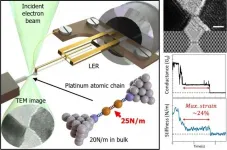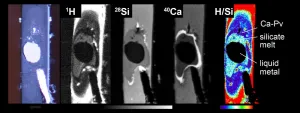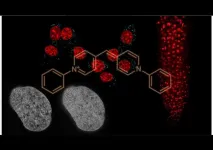(Press-News.org) While it has been said that the eyes are a window to the soul, a new study shows they could be a means for understanding diseases of the brain. According to new research by scientists at the UCSF Weill Institute for Neurosciences, retinal scans can detect key changes in blood vessels that may provide an early sign of Alzheimer's, while offering important insights into how one of the most common Alzheimer's risk genes contributes to the disease.
"The most prevalent genetic risk for Alzheimer's disease is a variant of the APOE gene, known as APOE4," said lead author Fanny Elahi, MD, PhD. "We still don't fully understand how this variant increases risk of brain degeneration, we just know that it does, and that this risk is modified by sex, race, and lifestyle. "Our research provides new insights into how APOE4 impacts blood vessels and may provide a path forward for early detection of neurodegenerative disease."
Studies in mice have explored the effect of APOE4 on capillaries in the brain. Elahi, an assistant professor of neurology and member of the UCSF Memory and Aging Center (MAC), has long suspected these tiny blood vessels may play a significant role in Alzheimer's disease, since they deliver nutrients and oxygen, carry away waste, and police immune system responses through the protective shield known as the blood-brain barrier. Damage to these blood vessels could cause a host of problems, she says, including the protein buildup and cognitive decline seen in individuals affected by Alzheimer's disease.
Because the technology does not exist to visualize individual capillaries in living people's brains, Elahi and colleagues turned to the eye. In the new study, which published May 11, 2021, in the journal Alzheimer's and Dementia: Diagnosis, Assessment & Disease Monitoring, Elahi and her team have shown that APOE4-associated capillary changes can be detected in humans through an easy, comfortable eye scan. As a light-penetrating tissue that shares biology with the brain, the retina, researchers believe, may help determine what APOE4 variants may be doing to similar capillaries inside the brain, even in those without dementia.
The team - which includes Ari Green, MD, a neuro-ophthalmologist, professor, and director of the UCSF Neurodiagnostics Center, and Amir Kashani, MD, PhD, associate professor of ophthalmology at the Johns Hopkins Wilmer Eye Institute - used an advanced retinal imaging technique known as optical coherence tomography angiography (OCTA) to peer into the eyes of aging people with and without APOE4 mutations to evaluate the smallest blood vessels at the back of the eye.
The team leveraged the well-characterized cohorts of people enrolled in ongoing studies of brain aging and neurodegenerative disease at the MAC. By adding OCTA scans to existing MRI and PET scan data, they gain comparative insights without putting volunteer participants through additional discomfort. "That's the beauty of this technique," Elahi said. "It's very easy, noninvasive and participant-friendly."
Analyzing the retinal scans, the researchers found reduced capillary density in APOE4 carriers, an effect that increased with participant age. To test whether those scans accurately reflected what was happening in the brain, the team then compared the abnormalities seen in OCTA scans of retinal capillaries to measurements of brain perfusion, or the flow of blood through the brain, as measured via MRI. They found that people with higher retinal capillary density also had greater blood flow in the brain.
Finally, the team looked to participants with prior PET scans of beta-amyloid, the protein associated with Alzheimer's disease, to see how their retinal capillary measurements related to the burden of amyloid plaques in the brain, which is the major focus of Alzheimer's disease diagnosis, research and treatment to date. They found that capillary density did not differ between groups with and without amyloid plaques, nor did it vary along with amyloid burden. According to Elahi, that independence suggests that capillary abnormalities are unlikely to be driven by amyloid pathology, or that their relation may at most be indirect.
"This is the first time that we have demonstrated in living, asymptomatic humans that the smallest blood vessels are affected in APOE4 gene carriers," said Elahi. That's important, she added, because it suggests that the increased risk of brain degeneration and Alzheimer's disease in APOE4 carriers may be through its effect on blood vessels.
Elahi and her colleagues plan to follow their study participants to better understand blood vessel dysfunction at a molecular level. That work could help detect the onset of Alzheimer's disease before significant damage occurs to the brain and identify new vascular targets for early treatment.
"This is just the beginning," Elahi said. "But the implications for early detection and possible intervention can be significant in combatting Alzheimer's disease and other neurodegenerative disorders. It's much harder to regenerate neurons than to stop their degeneration from happening in the first place. Similar to cancer, early detection can save lives,"
INFORMATION:
Additional co-authors on the paper include Daniel Bennett, Samantha Walters, Renaud La Joie, PhD, Amy Wolf, Yann Cobigo, Adam Stafferoni, Howie Rosen, MD, Bruce Miller, MD, Gil Rabinovici, MD, Joel Kramer, PsyD, and Ari Green, MD, from UCSF. For additional authors and funding information, please see the paper.
About UCSF: The University of California, San Francisco (UCSF) is exclusively focused on the health sciences and is dedicated to promoting health worldwide through advanced biomedical research, graduate-level education in the life sciences and health professions, and excellence in patient care. UCSF Health, which serves as UCSF's primary academic medical center, includes top-ranked specialty hospitals and other clinical programs, and has affiliations throughout the Bay Area. UCSF School of Medicine also has a regional campus in Fresno. Learn more at ucsf.edu, or see our Fact Sheet.
Follow UCSF
ucsf.edu | Facebook.com/ucsf | YouTube.com/ucsf
Climate change is exacerbating problems like habitat loss and temperatures swings that have already pushed many animal species to the brink. But can scientists predict which animals will be able to adapt and survive? Using genome sequencing, researchers from McGill University show that some fish, like the threespine stickleback, can adapt very rapidly to extreme seasonal changes. Their findings could help scientists forecast the evolutionary future of these populations.
A popular subject of study among evolutionary ecologists, stickleback are known for their different shapes, sizes, and behaviours - they can even live in both seawater and freshwater, and under a wide range of temperatures. But what ...
Plants have evolved unique immunity mechanisms that they can activate upon detecting the presence of a pathogen. Interestingly, the presence of some nonpathogenic microorganisms can also prompt a plant to activate its systemic immunity mechanisms, and some studies have shown that pretreating agricultural crops with such "immunity-activating" nonpathogenic microorganisms can leave the crops better prepared to fight off infections from pathogenic microorganisms. In effect, this means that immunity-activating nonpathogenic microorganisms can function like vaccines for plants, providing a low-risk stimulus for the plant's immune system that prepares it for dealing with genuine threats. These are exciting findings for crop scientists because they suggest the ...
Researchers at UC San Francisco have observed a new feature of neural activity in the hippocampus - the brain's memory hub - that may explain how this vital brain region combines a diverse range of inputs into a multi-layered memories that can later be recalled.
Using a special "micro-grid" recording device developed by colleagues at Lawrence Livermore National Laboratory (LLNL), the UCSF researchers were able to measure hippocampus activity in study participants undergoing surgery to treat severe epilepsy. They discovered that brain waves travel back and forth across this structure, integrating messages ...
The international scientific community agrees that the latest findings of an FAU research team will revolutionise the entire chemistry of magnesium. The research team have discovered magnesium, which usually has a double positive charge in chemical compounds, in the elemental zero-oxidation state. They have published their ground-breaking findings in the journal Nature.
In the periodic table of elements, magnesium (Mg) is a metal with low electronegativity, which means it does not easily attract electrons but easily loses both the electrons in its outer shell during chemical reactions. It therefore only exists in nature as a compound ...
Ishikawa, Japan - Today, many well-studied materials in various fields, such as electronics and catalysis, are close to reaching their practical limits. To further improve upon modern technology and outperform state-of-the-art devices, researchers looking for new functional materials have to push the boundaries and explore more extreme cases. A clear example of this is the study of low-dimensional materials, such as monoatomic layers (2D materials) and monoatomic chains (1D materials).
It has been proved time and time again that low-dimensional materials exhibit exotic properties that are absent in their 3D bulk counterparts. For example, monoatomic chains of metals like gold ...
High-temperature and high-pressure experiments involving a diamond anvil and chemicals to simulate the core of the young Earth demonstrate for the first time that hydrogen can bond strongly with iron in extreme conditions. This explains the presence of significant amounts of hydrogen in the Earth's core that arrived as water from bombardments billions of years ago.
Given the extreme depths, temperatures and pressures involved, we are not physically able to probe very far into the earth directly. So, in order to peer deep inside the Earth, researchers use techniques involving seismic data to ascertain things like composition and density of subterranean material. Something that has stood out for as long as these kinds of measurements have been taking place is that the core is primarily ...
The ease with which anyone can create online content for free, especially on social media, has led to superabundance of information being one of the defining characteristics of today's communication systems. This situation has resulted in increasingly intense competition for attention, which has become a scarce good. The researchers from the Complex Systems group (CoSIN3) at the UOC's Internet Interdisciplinary Institute (IN3) María José Palazzi and Albert Solé --professor at the Faculty of Computer Science, Multimedia and Telecommunications?--, led by Javier Borge, have participated in the design of ...
When it comes to ancient Roman imperial architecture, most people usually have a mental image of white marble statues, columns, or slabs. While it is true that many buildings and squares at that time were decorated with marble, it was frequently not white but colored marble that was employed, such as the green-veined Cipollino Verde, which was extracted on the Greek island of Euboea. Because marble was very expensive, it was often placed in thin slabs as a cladding over other, cheaper stones. "To date, however, no actual remains of marble workshops from the Roman imperial era have been found, so little is known about marble processing during this period," said Professor Cees Passchier ...
An international research team analyzed a database of more than 1000 supernova explosions and found that models for the expansion of the Universe best match the data when a new time dependent variation is introduced. If proven correct with future, higher-quality data from the Subaru Telescope and other observatories, these results could indicate still unknown physics working on the cosmic scale.
Edwin Hubble's observations over 90 years ago showing the expansion of the Universe remain a cornerstone of modern astrophysics. But when you get into the details ...
A group of scientists at Nagoya University, Japan, have developed an incredibly versatile DNA fluorescent dye, named 'Kakshine' after a former NU student of its members, Dr Kakishi Uno, but it also means to make the nucleus shine brightly, since the nucleus is pronounced 'Kaku' in Japanese. Dr Uno, with Dr Yoshikatsu Sato and Nagisa Sugimoto, the other two members of the research team at the Institute of Transformative Bio-Molecules (ITbM), succeeded in developing a DNA binding fluorescent dye with the pyrido cyanine backbone, which satisfied the three principal qualities required of such a dye - that it have high selectivity for DNA, ability to use visible light with limited phototoxicity, ...





